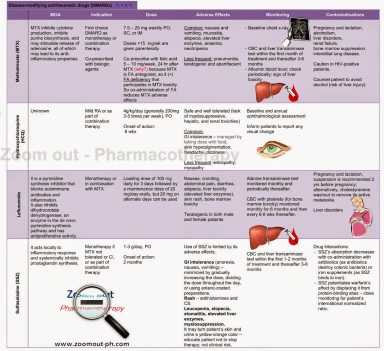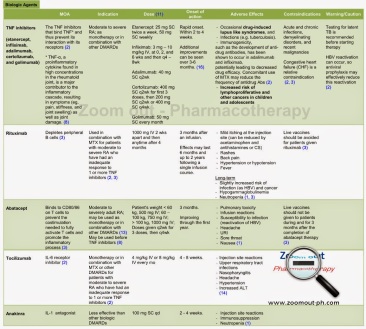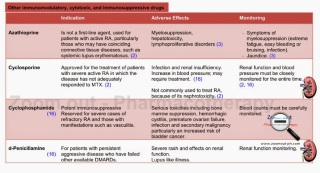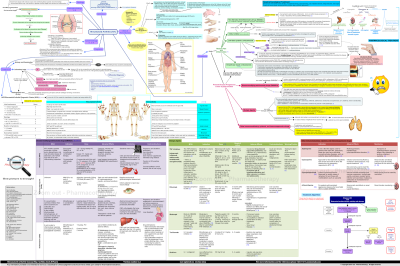 |
| Rheumatoid Arthritis Concept Map – Click to enlarge image |
Rheumatoid Arthritis Concept Map: An Overview
You can access this map for free. But if you want it as a printable version or a folded poster, please order here.
Definition
Etiology
Epidemiology
Pathophysiology
Reaction” and ends by “Joint Destruction.”
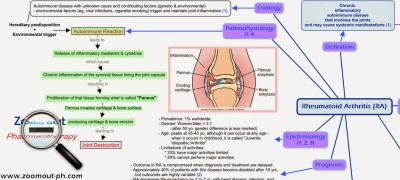 |
| Etiology and Pathophysiology of Rheumatoid Arthritis |
Clinical Presentation
symmetric, include:
Irreversible Joint Deformities may occur due to disease progression
- Ulnar deviation of the fingers
- Boutonniere Deformity (hyperextension of the DIP & flexion of the PIP joint)
- Swan Neck Deformity (hyperextension of the PIP & flexion of the DIP joint)
- Hammer toe deformity
Extra-articular Manifestations
Most of rheumatoid arthritis extra-articular manifestations are collected in this image:
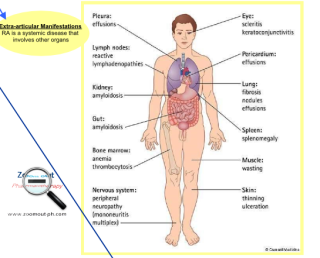 |
| Rheumatoid arthritis extra-articular manifestations |
Diagnosis
 |
| Rheumatoid Arthritis vs Osteoarthritis |
Treatment
Medications to Reduce Pain and Inflammation
1) Non-Steroidal Anti-inflammatory Drugs (NSAIDs)
– adverse effects: GI toxicity, headache, confusion and other CNS symptoms, increased BP, worsening of hypertension, edema, and decreased platelet function. NSAIDs increase cardiovascular risk.
Non-steroidal anti-inflammatory drug drugs mechanism of action is shown in this diagram:
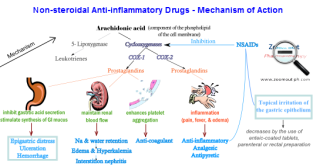 |
| Non-steroidal Anti-inflammatory Drugs – Mechanism of Action |
2) COX-2 inhibitor (only celecoxib)
See the map.
3) Low-dose systemic corticosteroids (CS)
- adjunctive therapy
- decrease inflammation and other symptoms rapidly and efficiently
- slow bone erosion
When to use low-dose systemic CS in RA?
- In early RA, low-dose oral prednisone (<10mg/day) in combination with DMARDs for up to 6 months, as symptomatic effects ↓ with time
- In established RA, CS may be used as ‘bridging’ therapy when DMARDs are initiated, and should be withdrawn once
DMARDs have controlled the disease - May be used for severe joint or systemic manifestations of RA (eg, vasculitis, pleurisy, pericarditis)
Contraindications
- Relative contraindications include PUD, HTN, untreated infections, DM, and glaucoma
- The risk of latent TB should be considered before CS therapy is begun
4) Intraarticular depot corticosteroids
Medications to Prevent Disease Progression & loss of joint function
1) Disease-modifying antirheumatic drugs (DMARDs)
sulfasalazine (SSZ), and leflunomide.
- Early treatment of RA (< 6 months after the onset of symptoms) with DMARDs retard disease progression more efficiently and induce more remissions.
- Until the full action of DMARDs takes effect, anti-inflammatory or analgesic medications may be required as bridging therapy to reduce pain and swelling.
- They differ from each other chemically and pharmacologically.
- Patients should be informed about the risks of DMARDs and monitored closely for evidence of toxicity.
- Combinations of DMARDs may be more effective than single drugs. Also, combining a DMARD with another drug, such as methotrexate plus a TNF-α antagonist or an IL-1 receptor antagonist or a rapidly tapered corticosteroid, may be more effective than using DMARDs alone.
A comparison between DMARDs is available in the map. The comparison is showing: mechanisms of actions, indications, doses, adverse effects, monitoring parameters, and contraindications.
2) Biologic Agents
- Also called “biologic DMARDs”
- They are not given in combination with each other due to increased frequency of infections.
- Approved by the FDA to treat moderate to severe RA not responded to an one or more of the traditional DMARDs
- They may be used alone, but are often in combination with other DMARDs, to increase the efficacy and decrease AE
- Start biologic agents while patients remain on NSAID and/or corticosteroid
3) Other immunomodulatory, cytotoxic, and immunosuppressive drugs
- Efficacy is similar to DMARDs but more toxic.
- Used in case of treatment failure with DMARDs or to ↓ the need for CSs.
- Used infrequently unless there are extra-articular complications.
And here is a comparison between them:
We hope you find Rheumatoid Arthritis Concept Map helpful. Please let us know your opinion in a comment below. You can access this map for free. But if you want it as printable version or a folded poster please order below.
Version: 2.0
Last updated in: 10 June 2014
